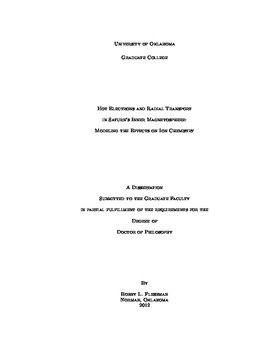| dc.contributor.advisor | Bagenal, Fran | |
| dc.contributor.advisor | Delamere, Peter | |
| dc.contributor.author | Fleshman, Bobby | |
| dc.date.accessioned | 2014-03-24T20:53:35Z | |
| dc.date.available | 2014-03-24T20:53:35Z | |
| dc.date.issued | 2012 | |
| dc.identifier.uri | https://hdl.handle.net/11244/8104 | |
| dc.description.abstract | The E-ring of Saturn, located just beyond the main rings at four Saturn radii, was known to be made mostly of water and its by-products before the Cassini spacecraft arrived at Saturn in 2005. Since then, Cassini has observed water geysers on the tiny moon of Enceladus ejecting ≈ 100 kg of water per second into orbit around Saturn, which most agree is the chief contributor to neutrals in the E-ring. Following several key reactions, many of these neutrals go on to populate large, tenuous structures, known as neutral clouds, extending 10s of Saturn radii. | en_US |
| dc.description.abstract | The other side of the story are the ions, which are largely created by the ionization of same neutrals sourced from Enceladus. A key distinction between the neutrals and ions is that ions are carried along by Saturn’s magnetic field, and revolve around Saturn at the rotation rate of the planet, while neutrals generally have much slower Keplerian speeds. | en_US |
| dc.description.abstract | It is the study of the chemical interaction of these separate, but related populations that is the subject of this thesis. We have developed a series of models to study how the coupling of these systems affect details of the other, such as composition. | en_US |
| dc.description.abstract | The first step (Chapter 2) was the development of a water-group physical chemistry model, which includes suprathermal electrons and the effect of radial ion transport. With this “one-box” model, we are able to reproduce observed water and hydrogen ion densities in Enceladus’s orbit, but only when the hot electron density is ≈ 0.5% of the total plasma density. Radial transport is found to be slow, requiring 26 days to remove ions from the orbit of Enceladus. | en_US |
| dc.description.abstract | Moving toward the development of a radial model of ion chemistry, in Chapter 4 we present a model of Saturn’s neutral clouds, which are made of material outgassing from Enceladus. The effects of dissociation and charge exchange are considered, where the details of the latter prove to be of great consequence on neutral cloud morphology. The oxygen cloud is found to the most extended, followed by H2O, and finally OH. | en_US |
| dc.description.abstract | The above efforts are combined in Chapter 5, where a neutral cloud model is used to construct a radial model of ion chemistry. It is shown that neutral H2O requires more spreading than yet modeled in order to recover observed water and hydrogen ion abundances near Enceladus. The relative abundance of water-group ion species presented will be useful for analyses of CAPS-IMS data, while loss rates derived from the model can be used to improve neutral cloud models. The case is made that ion chemistry models and neutral cloud models must be developed alongside one another in order to improve understanding of these interrelated populations at Saturn. | en_US |
| dc.language | en_US | en_US |
| dc.subject | Physics, Astronomy and Astrophysics. | en_US |
| dc.subject | Chemistry, Physical. | en_US |
| dc.subject | Atmospheric Sciences. | en_US |
| dc.title | Hot Electrons and Radial Transport in Saturn’s Inner Magnetosphere: Modeling the Effects on Ion Chemistry | en_US |
| dc.contributor.committeeMember | Baron, Edward | |
| dc.contributor.committeeMember | Cowan, John | |
| dc.contributor.committeeMember | Branch, David | |
| dc.contributor.committeeMember | Kantowski, Ron | |
| dc.contributor.committeeMember | Rice, Charles | |
| dc.date.manuscript | 2012 | |
| dc.thesis.degree | Ph.D. | en_US |
| ou.group | College of Arts and Sciences::Homer L. Dodge Department of Physics and Astronomy | |
